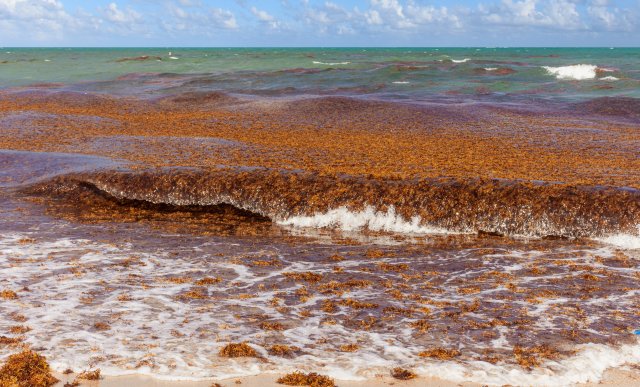Great Atlantic Sargassum Belt (GASB)
Related information in Spanish
During the summer of 2011, a new, large aggregation of Sargassum occurred in the Tropical Atlantic Ocean, outside the Sargassum Sea. This algal aggregation caused human health, economic, and environmental problems for coastal areas when unprecedented quantities of free-floating Sargassum inundated the shores of many islands of the eastern Caribbean (i.e., Lesser Antilles). Similar algal aggregations in the same area have subsequently occurred in most years, increasing in size and stretching over 8,850 km or 5,499 miles along the central Atlantic from the coast of west Africa to the Caribbean and Gulf of America, garnering the name the Great Atlantic Sargassum Belt (GASB). The 2018 GASB was the largest seen at the time and its biomass was estimated at more than 20 million tons. In the Caribbean, the Sargassum inundation events (SIEs) associated with the 2018 GASB filled some bays with tens to hundreds of thousands of metric tons of Sargassum in a matter of hours. During this event hundreds of beaches from French Guyana and the Atlantic coast of Trinidad in the south to Mexico and Florida in the north experienced massive inundations of Sargassum. In 2022, the GASB was even larger- with an estimated biomass of 22 million tons. There is currently no prediction for how extensive and recurrent these GASB events may become nor how long they may last.
References:
- Burrowes, R., Wabnitz, C., & Eyzaguirre, J. (2019). The great Sargassum disaster of 2018. ESSA.
- Franks, J. S., Johnson, D. R., Ko, D. S., Sanchez-Rubio, G., Hendon, J. R., & Lay, M. (2011). Unprecedented influx of pelagic Sargassum along Caribbean Island coastlines during summer 2011. Proceedings of the 64th Gulf and Caribbean Fisheries Institute October 31 - November 5, 2011 Puerto Morelos, Mexico, 64, 6-8.
- Gower, J., & King, S. (2011). Distribution of floating Sargassum in the Gulf of America and the Atlantic Ocean mapped using MERIS. International Journal of Remote Sensing, 32(7), 1917-1929.
- Wang, M., Hu, C., Barnes, B. B., Mitchum, G., Lapointe, B., & Montoya, J. P. (2019). The great Atlantic Sargassum belt. Science, 365, 83-87.

